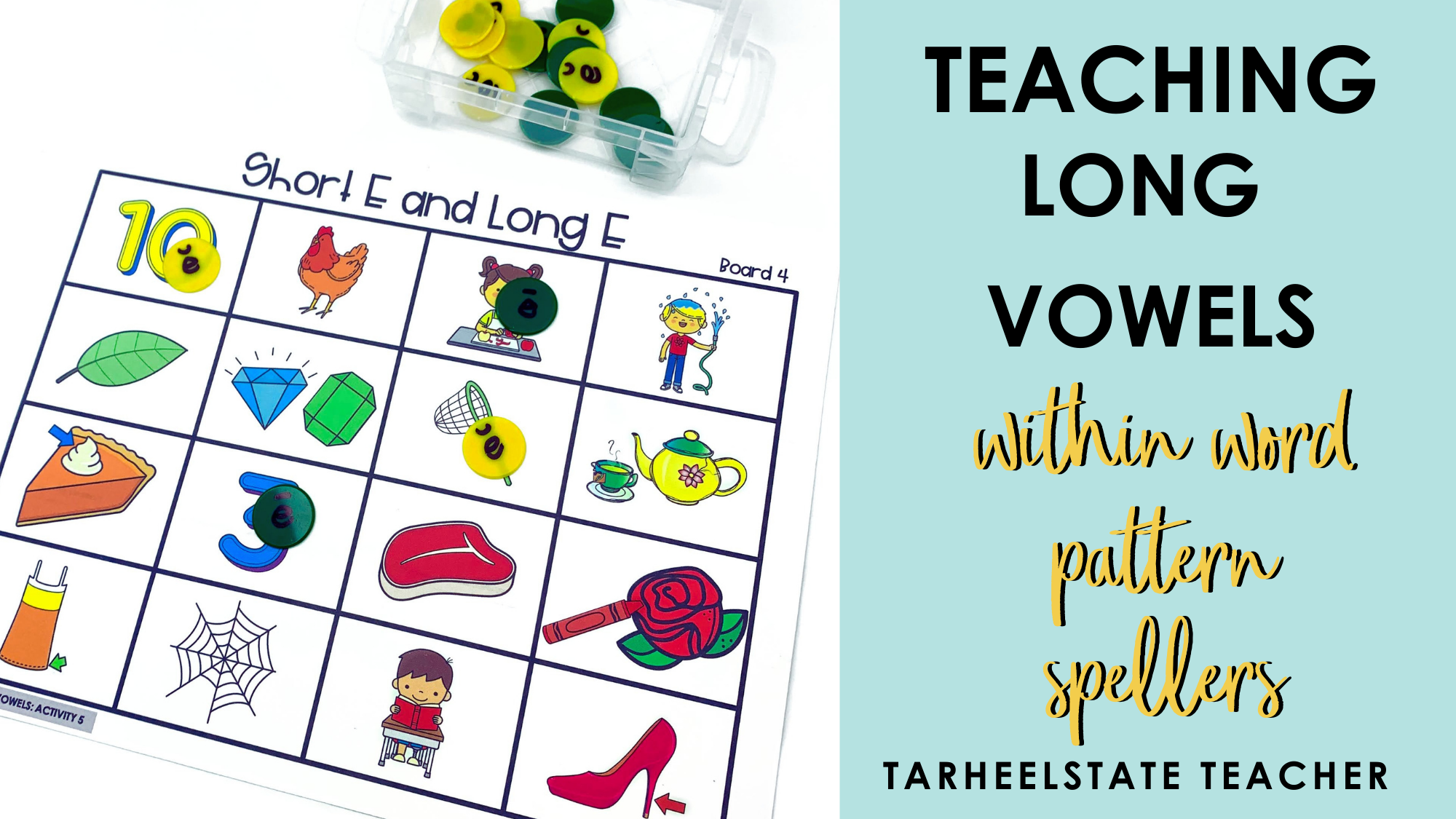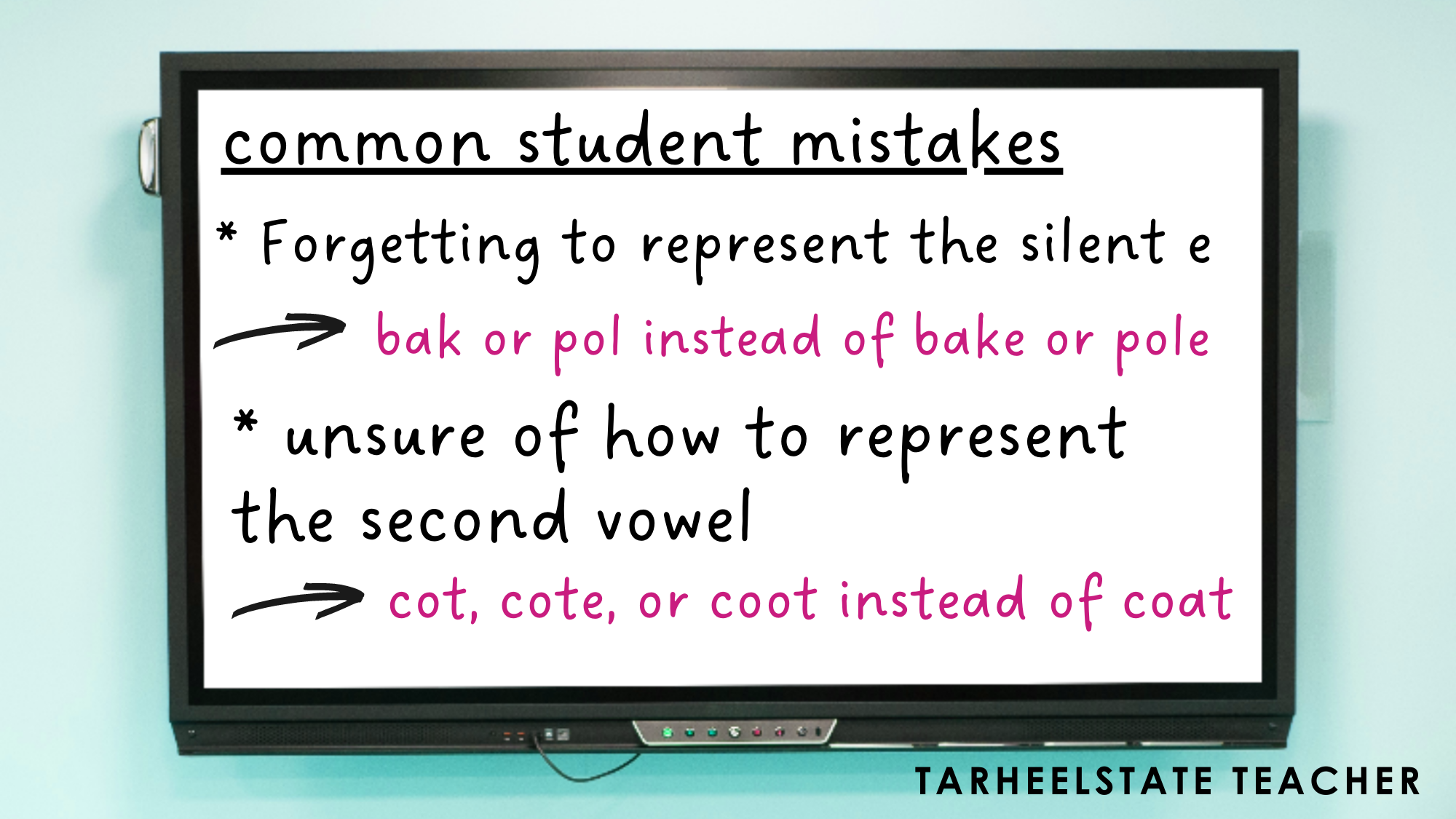Teaching Long Vowel Sounds - Within Word Pattern Spellers
Preparing to teach students about long vowels? In this post you will find information about common and less common long vowel patterns including when students are developmentally ready to learn about them, examples of each long vowel spelling pattern, what common spelling mistakes to expect from students, and ideas for how to make learning about long vowels fun.
What is a Long Vowel Sound?
First, let’s cover the basics. A long vowel is a vowel that “says its name” or is pronounced the same as the way the letter name is said.
What Long Vowel Patterns are Common?
Long A - CVCe and CVVC - blame, space, train, chain
Long O - CVCe and CVVC - stone, robe, goal, float
Long U - CVCe and CVVC - cube, broom, juice
Long E – CVVC - feet, sleep, team, teach
Long I - CVCe - bite, kite, cite
Review CVVC Pattern (AI, OO, EE, EA, OA) - wait, booth, wheel, beast, throat
* Note: I've linked each of these long vowel patterns to resources that can be used to teach these skills. You can find the bundle for teaching Common Long Vowel Patterns here.
The most common long vowel pattern, and usually the first one students learn when introduced to long vowel sounds is the CVCe pattern. Students tend to be introduced to long vowel sounds by comparing them to CVC words that all make short vowel sounds, like cap, kit, not, and tub. Students are taught that when a CVC word is followed by an e, the e is not sounded (silent) and it changes the original short vowel sound to a long vowel sound. So a silent-e changes cap, kit, not, and tub changes to cape, kite, note, and tube.
The CVVC pattern is another very common long vowel pattern. Students learn that when two vowels are paired together between two consonants, the first vowel makes a long vowel sound. For example, when an o is paired with a, the o will make a long vowel sound like "goat" vs "got".
What Long Vowel Patterns are Less Common?
Once students in the Within Word Pattern stage become comfortable with common long vowel patterns, CVCe and CVVC, they begin to delve into less common long vowel patterns. These include:
Long A - CVV Open Syllable AY - clay, play, say
Long O - CVV Open Syllables OW and OE - toe, foe, tow, grow
Long O - CVCC and VCC ST, LD, TH, LL - most, told, cold
Long U - CVV Open Syllable EW and UE - stew, brew, clue, fuel
Long E – CVVC EA - each, reach, dream
Short E - CVVC EA - head, bread, lead
Long I - CVCC IGH - might, night, high
Long I - Y = I CV Open Syllable - dry, fly, try
Long I - CVCC and VCC ND, LD - kind, wild, mind
IE and EI Words - brief, chief, piece, and weight, sleigh, vein
* Note: I've linked each of these long vowel patterns to resources that can be used to teach these skills. You can find the bundle for teaching Less Common Long Vowel Patterns here.
While these long vowel patterns are less common, it doesn’t mean that they are not useful for students to learn. On the contrary, because students see these less common patterns less often, they benefit from more encounters with these vowel patterns so that they learn the various ways that long vowels are spelled. This also benefits their reading fluency and accuracy.
In what grade-level are Long Vowel Sounds taught?
If you made it to this post, you must be teaching a grade (or have a child in a grade) where Long Vowel Sounds are taught (haha!). While I don't think of spellers based on grade-level because I use the Words Their Way continuum of spellers to assess my students, it's helpful to know what is typical for teaching Long Vowel Sounds.
Students working on Long Vowel Patterns in the Early Within Word Pattern Stage are typically in 2nd-3rd grade, but you may find that some 1st grade students fall into this stage and that some 4th-5th graders are still developing these skills. As a 5th grade teacher, I always had one or two small groups that were in the Within Word Pattern stage.
What are some common mistakes students make when writing and spelling Long Vowel Sounds?
#1: Arguably the most common mistake students make when spelling words with long vowel sounds is representing the vowel that is heard and omitting the vowel that is silent, short, or unaccented.
Example → When students are trying to write bake, fume, or pole, they may forget to represent the silent e and write bak, fum, or pol because they don’t hear the e when sounding out the word.
#2: Until they have had enough repeated practice and encounters with CVVC words, students also commonly make mistakes when trying to represent the second vowel in a CVVC word, sometimes omitting it all together or struggling with which vowel to choose and even where to put it when spelling the word.
Example → When trying to spell the word coat, students may write cot, cote, or coot.
#3: Finally, words ending in open syllables typically cause a lot of confusion for early Within Word Pattern Spellers. An open syllable is simply a syllable that has a vowel at the end of it; the syllable is “open” because nothing comes after it. Students in this stage quickly learn that open syllables make long vowel sounds, however, they often initially struggle with spelling accuracy because the CV and CVV spelling patterns are new to them.
Example → When trying to spell lay, chew, or cry, students may represent them as la, chu, or cri.
Why Picture Sorts and Picture-Based Activities for Early Within Word Pattern Spellers?
Initially you may have students in the early stages of Within Word Patterns who struggle to accurately read the words they are studying. Picture sorts provide a bridge to support these students. However, incorporating picture-based activities can benefit students in all stages of Within Word Pattern! When students are challenged to build or write words being depicted by an image, they are forced to practice their phoneme segmentation skills, or what they hear in a word rather than what they see, in conjunction with the vowel patterns they are studying in order to accurately spell a word.
What are some activities that make learning long vowel sounds fun?
What makes everything fun for students? Games of course! In the partner game Jump to June, players take turns drawing vowel pattern cards and moving their game pieces to the next word on the path that corresponds with the vowel pattern drawn. After each move, players record the word they landed on to their recording sheet, sorting it under the appropriate vowel pattern. When both players reach the end of the path, they compare the number of long u words collected on their recording sheet to determine who wins the game.
This game requires students to focus in on short u vs. long u vowel patterns and use their knowledge of the sounds created by the patterns to decide where to move on the board.
Spin, Cover, Build, Write is also one of my favorite activities to use for students in the Early Within Word Pattern stage.
Students spin to cover an image that has the long vowel sound or pattern that was spun. Then, students write the word they covered on their recording sheet under the correct column, attempting to spell the word correctly. I often also require my students to build the words with letter tiles before writing them.
Some other games and activities that students typically play during our long-vowels unit include:
Board Games
Follow the Path
Clip-Board and Spinner Style Collection Game
Say, Listen, Match matching card game
Spin, Cover and Spin, Cover, Build, Write
Match it Up!
Guess My Word (similar to Guess Who?)
4 in a Row (similar to Connect Four)
You can find all these games and activities in the Common Long Vowels CVCe and CVVC Bundle and the Less Common Long Vowel Patterns Bundle.
CHEERING YOU ON AS YOU SUPPORT YOUR STUDENTS LEARNING THIS SKILL!
When it comes to teaching long vowel sounds, I believe that the more exposure and practice students get, the stronger readers and spellers they become! Not only does incorporating game play into our word study routine provide an additional opportunity for students to practice and apply what is being taught, but adding games and play-based activities adds some much needed variety and engagement to our word study block.
Looking for more Within Word Pattern Resources?
You can get all of the Within Word Pattern Stage games and activities in a time-saving , money saving bundle!




